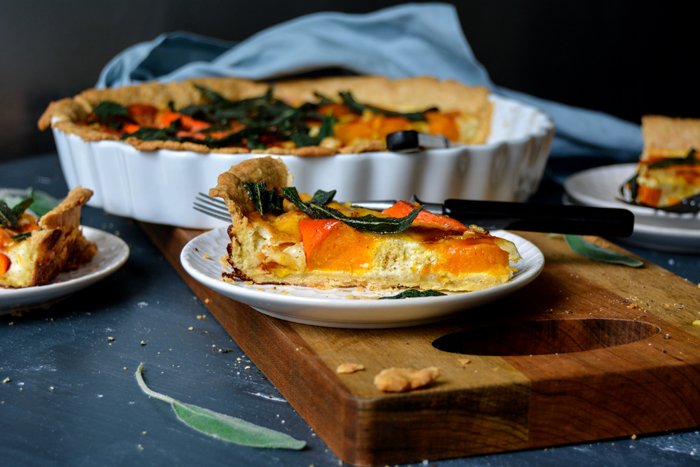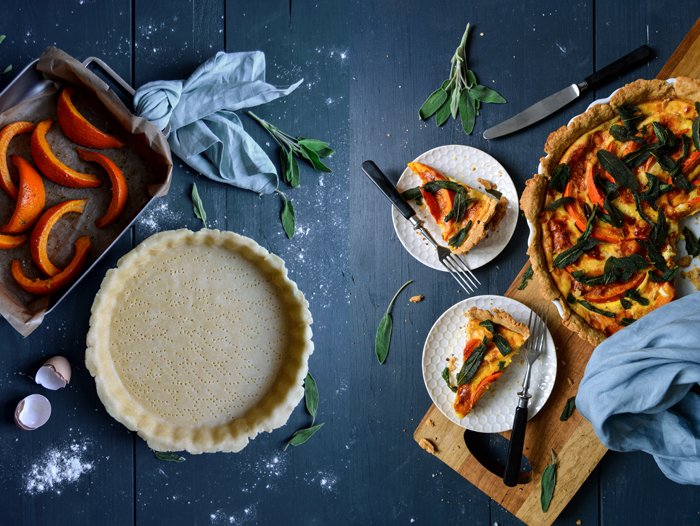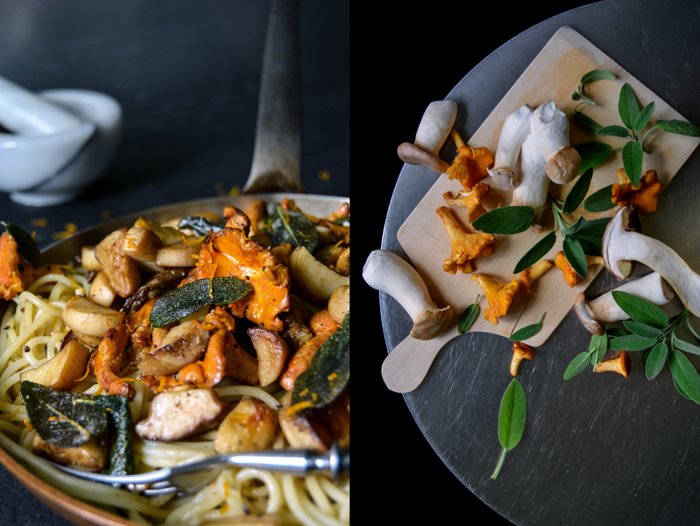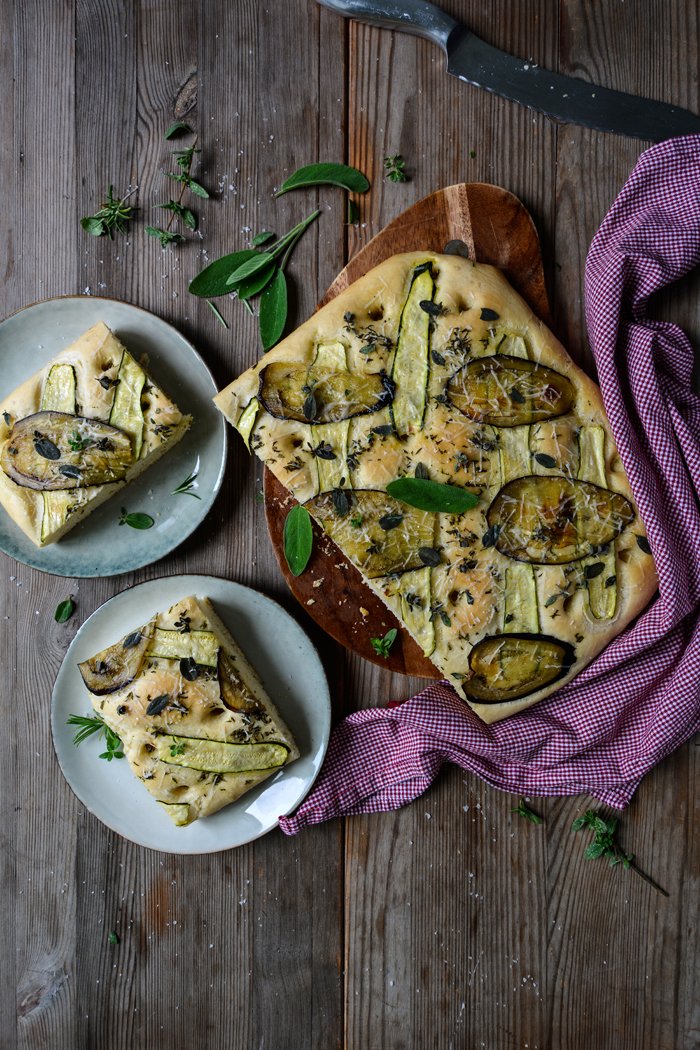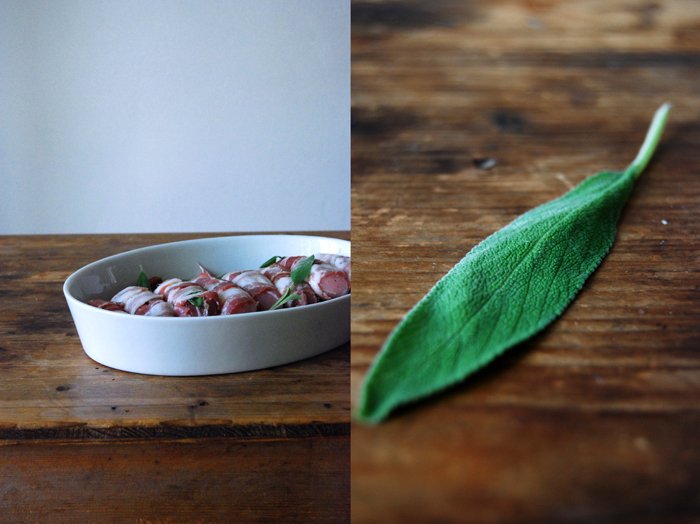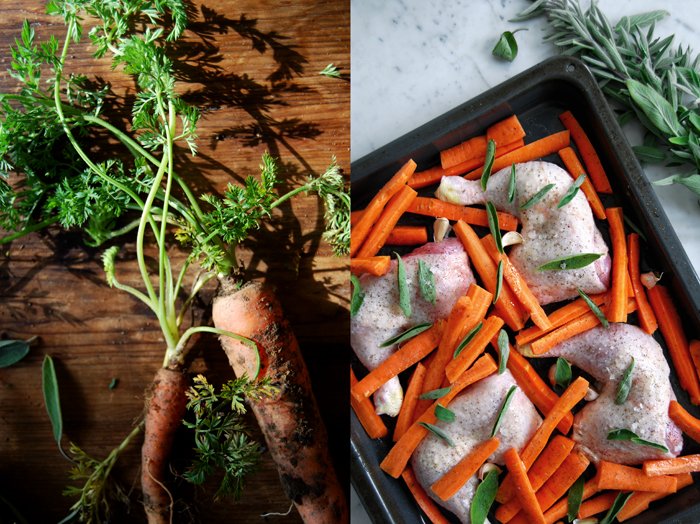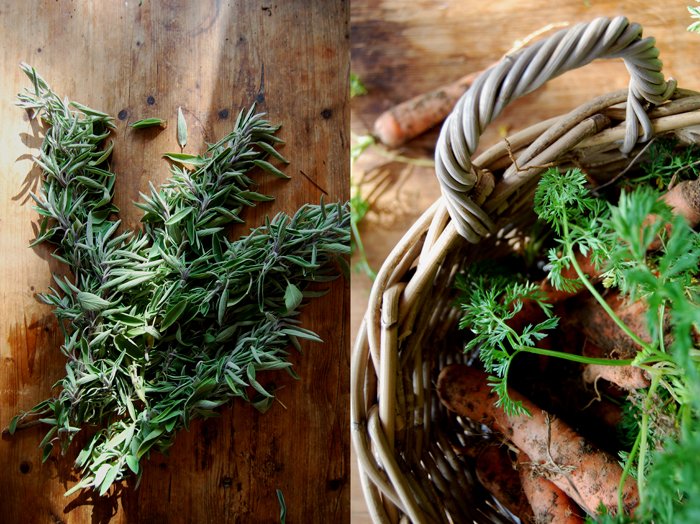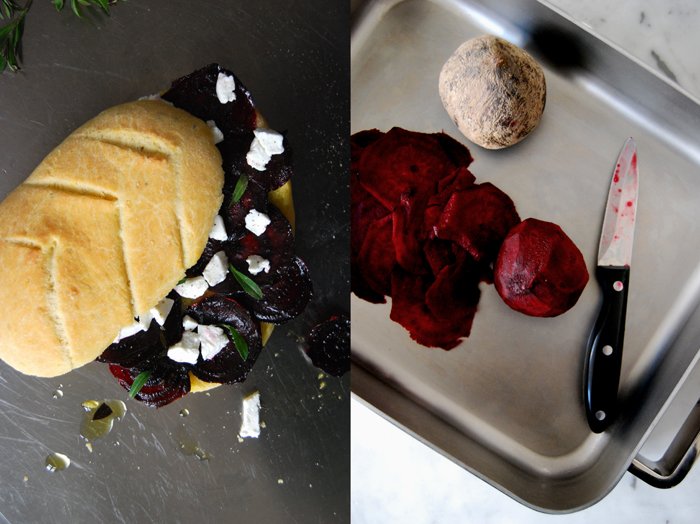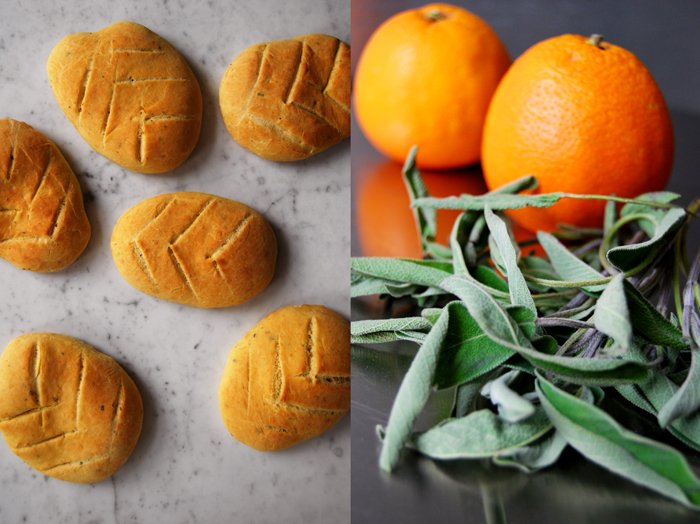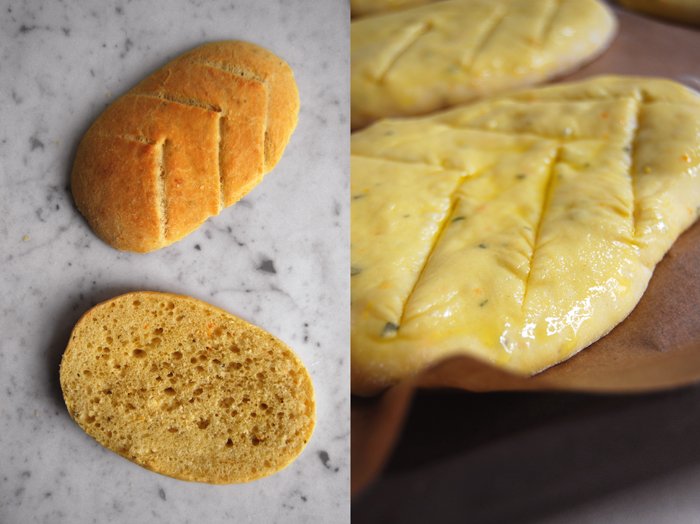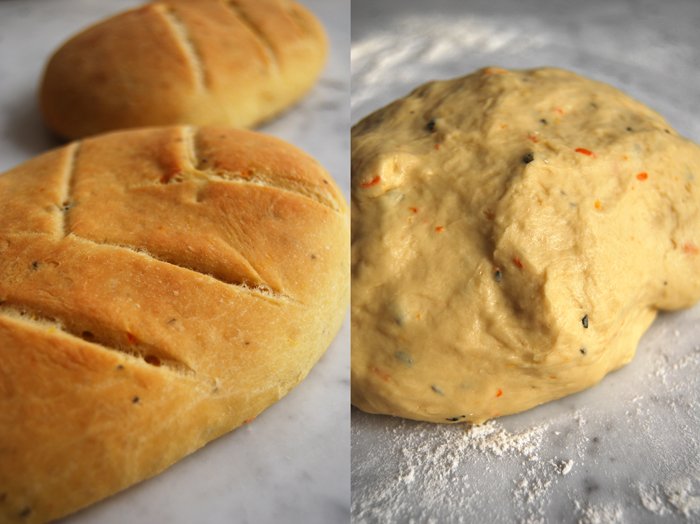Berlin & 365's Autumn Quiche with Squash, Taleggio & Sage
My editor at Prestel in New York asked me one day where I'd like to launch my new book. Berlin, I said, and Malta, of course, and London, and NYC, and the West coast this time, LA and San Francisco. It's nice to dream and imagine all these places on both sides of the Atlantic, to think of all the people I'd meet and who'd celebrate 365 together with me. I'm good at dreaming but I'm bad at not following a dream. It makes me restless, once my mind is set on something it doesn't want to stop until it gets there. Sometimes my dreams don't work out, sometimes they do - even though everybody around me has given up hope. And sometimes they happen to be even better than I hoped they'd be.
There are many ways to launch a book, but I wanted a feast - in six cities. There are many reasons why a dream works out, luck (always), persistence (tiring for everyone around), thoughtful planning (I studied architecture, I'm good at that), and help and support from others (and I got a lot of that). In the next couple months I'll share some impressions of the six 365 book launch events here on the blog, I'll write about the places and what I love so much about them, and about the people who made all this possible. And to give you a little taste of this book tour, I'll always share one of the recipes that we enjoyed at the events. So I'll start with Berlin, my home, the place where my adventurous journey began, and with the recipe for the Squash and Taleggio Quiche with Crispy Sage (you can find it in the book, recipe no. 287, and below). This quiche became the cover of 365 and quickly gained fans and fame all around the globe.
On the morning of September 23rd I started to feel nervous, it was the publication day of the German 365 and the day on which I'd step out of my comfort zone and talk about the book that I'd been working on for so many days and nights. It feels good when a book is out, you can't change anything anymore and at one point you even stop dreaming about gram-to-cup conversions but it's also the time when people start seeing what you've created, when it's not just you and the book anymore. It's scary.
So I kept myself busy during the day (the best strategy to calm my antsy mind), I went to the hair dresser (thank you Jay for dealing with my anxious self) and then drove straight to the Hotel de Rome, a former bank turned into the hotel of your dreams where 365 would soon see the most marvelous of celebrations. Türkan Arikan, the hotel's Director of Communications and the best event partner an author could ask for, had reserved the stunning roof terrace for our launch - my favourite spot for a summery sundowner - but Berlin's weather was set on drizzle, wind, and grey, no blue skies and golden sunset. We took over Hotel de Rome's imposing Opera Court with our 100 guests instead, nibbled on hearty tastings from 365 prepared by the diligent kitchen crew, and on the bittersweet recipe no. 70 from 365, Tangerine Jam Chocolate Brownies baked by Fine Bagels' fabulous Laurel Kratochvila. A fair feast needs wine and we happily filled our glasses with the wonderful reds, whites, and rosé from Meridiana Wine Estate in Malta (thank you Karl Chetcuti for making Maltese wine that fills my heart and every room on the book tour with so much joy). Florian Domberger baked and shared Berlin's best bread with us, his crunchy, spongy Beutebrot. And I had a very honest, intimate talk about the book with my friend Cynthia Barcomi. This woman manages to fit more into one life than anyone else and her laugh is so charming and infectious that you totally forget that you're nervous and that you're talking about something that existed, not too long ago, only in your head before it became a book. Could I ask for more? No, it was a feast.
Thank YOU so much for all the love and support that you've already shown for 365! If you have a few minutes and you're in the mood, it would be great if you could write a review for the book on Amazon (here are the links for the US, UK, Germany).
You can see all the pictures of the Berlin book launch event here on Facebook. And if you cook or bake recipes from the book and share pictures on Instagram, you can add #365TheCookbook so that they show up in the book's collection. If you feel like diving into the love that this book received so far, you can read about it here.
Squash and Taleggio Quiche with Crispy Sage
from '365 - A Year of Everyday Cooking & Baking' (Prestel, 2019)
Serves 4 to 8
For the filling
1 1/3 pounds (600 g) seeded squash, preferably peeled butternut or Hokkaido with skin, cut into 1-inch (2.5 cm) wedges
1 tbsp olive oil
Flaky sea salt
Finely ground pepper
3 large eggs
3/4 cup (175 g) sour cream (or crème fraîche)
1/2 cup (120 ml) heavy cream
1 tsp fine sea salt
Nutmeg, preferably freshly grated
5 ounces (140 g) mild, sweet cheese that melts well, such as Taleggio, fontina, or Robiola, diced
3 tbsp (45 g) unsalted butter
50 large fresh sage leaves
For the pastry
2 cups (260 g) all-purpose flour
1 tsp fine sea salt
1/2 cup plus 1 tbsp (130 g) unsalted butter, cold
1 large egg
Preheat the oven to 400°F (200°C).
For the filling, spread the squash in a large baking dish, drizzle withthe olive oil, and toss to combine. Season to taste with flaky sea salt andpepper and roast for 15 minutes then flip the squash and continue roasting for10 to 15 minutes or until golden and tender; set aside.
For the pastry, combine the flour and fine sea salt in the bowl of astand mixer fitted with the dough hook attachment. Add the butter and use aknife to cut it into the flour until there are just small pieces left. Quicklyrub the butter into the flour with your fingers until combined. Add the egg andmix with the hook until crumbly. Form the dough into a thick disc, wrap it inplastic wrap, and freeze for 10 minutes.
On a work surface, place the dough between 2 sheets of plastic wrap anduse a rolling pin to roll out into a disc, large enough to line the bottom andsides of a 12-inch (30 cm) quiche dish. Fit the dough into the quiche dish,pushing it into the dish, especially along the edges. Let the dough hang overthe rim a little or trim with a knife. Use a fork to prick the dough all over.Bake for 15 minutes or until golden. If the dough bubbles up, push it down witha fork. Take the quiche dish out of the oven and reduce the heat to 350°F (180°C).
In a medium bowl, whisk together the eggs, sour cream, heavy cream, andfine sea salt and season to taste with pepper and a generous amount of nutmeg.
Arrange the squash in a circle on top of the pre-baked pastry andsprinkle with the cheese. Pour the egg mixture over the squash and bake for 45to 55 minutes or until golden brown and firm. Take the quiche out of the ovenand let it sit at least 10 minutes.
In a large saucepan, heat the butter over medium-high heat, add thesage, and cook, stirring gently, for 20 to 30 seconds or until golden, green,and crispy—mind that the leaves don’t burn. Spread the sage on top of thequiche, sprinkle with a little pepper, and serve warm or cold.
Pumpkin Quiche with Taleggio and Crisp Sage
A quiche was one of the first savoury recipes that I made on my own and actually enjoyed. Learning to cook takes time but once you succeed, you get hooked on it. Whenever friends and family asked me to chip in with a dish for a birthday party, I used to make my quiche and felt more than happy about the applause I got for it. In the beginning, I used a more basic filling of leeks, tomatoes, and thyme, but then I got experimental: be it my Italian fennel tart, the combination of artichokes, olives, and Gruyère, spinach and gorgonzola, or green beans and ramps - I love them all. There are boundless possibilities to follow the seasons and your mood. However, its greatest quality is the buttery, flaky, utterly tempting pastry base. It's light and crisp and tastes so good that it wouldn't even need any topping.
One of the best ways to enjoy a quiche, is at a picnic on a lazy summer's day, but the warmer season is still far away, so I choose a filling that fits the cold and moody weather of March and goes well for a Sunday brunch with friends. I go for pumpkin, Taleggio, and crispy sage leaves fried in butter. It's pure comfort food. Usually, I like my quiche recipes warm or cold, I have no preference, but this recipe here is best when it's still warm. The soft cheese spreads its aroma and sinks into the sweet squash and woody-earthy sage. It's happy-making food.
I developed this quiche recipe for the West Elm blog, where you can also find this recipe and the long (!) wooden chopping board, the linen napkin, and stoneware plates. This post was sponsored by West Elm to make my kitchen a little prettier!
Pumpkin Taleggio Quiche with Crisp Sage
Makes a 30cm / 12″ quiche
For the filling
seeded pumpkin, peeled butternut squash or Hokkaido with skin, 600g / 1 1/3 pounds
olive oil 1 tablespoon
flaky sea salt
ground pepper
organic eggs 3
heavy cream 125ml / 1/2 cup
sour cream 175g / 3/4 cup
fine sea salt 1 teaspoon
nutmeg, preferably freshly grated, a generous amount
Taleggio (or another aromatic semi-soft cheese), diced, 150g / 5 ounces
butter 3 tablespoons
large fresh sage leaves 50
black peppercorns, crushed in a mortar
For the pastry
plain flour 260g / 2 cups
salt 1 teaspoon
butter, cold 130g / 4 1/2 ounces
organic egg 1
Preheat the oven to 200°C / 400°F (conventional setting). Line a large baking dish with parchment paper.
Cut the pumpkin into 5cm / 2" wedges and place them in the lined baking dish. Drizzle with the olive oil, use your hands to toss and coat the squash in the oil. Sprinkle with flaky sea salt and pepper and roast for 15 minutes. Turn the squash wedges over and continue roasting for about 15 minutes or until golden brown and soft when pricked with a fork. Cut the wedges in half lengthwise and set aside.
For the pastry, combine the flour and salt in a large bowl. Add the butter and use a knife to cut it into the flour until there are just small pieces left. Quickly rub the butter into the flour with your fingers until combined. Add the egg and mix with the dough hooks of an electric mixer until crumbly. Form the dough into a thick disc, wrap it in plastic wrap, and freeze for 12 minutes.
Place the dough between 2 sheets of plastic wrap and use a rolling pin to roll out into a disc, large enough to line the bottom and sides of a 30 cm / 12" quiche dish. Fit the dough into the quiche dish, pushing it into the dish, especially along the edges. Let the dough hang over the rim a little or cut it off with a knife. Use a fork to prick the dough all over. Bake for 15 minutes or until golden. If the dough bubbles up, push it down with a fork.
Take the baking dish out of the oven and set the temperature down to 180°C / 350°F.
For the filling, whisk the eggs, heavy cream, sour cream, salt, pepper and nutmeg.
Arrange the pumpkin in a circle on top of the pre-baked pastry and sprinkle with the taleggio. Pour the egg-cream mixture over the squash and bake for about 55 minutes or until golden brown, the top should be firm.
While the quiche is in the oven, cook the sage: Lay a kitchen paper on a large plate. Heat the butter in a large, heavy pan on medium-high heat. When the butter is sizzling, spread the sage in the pan and roast for about 20 seconds or until golden, turning the leaves gently once or twice. Mind that they don't become dark. Take the pan off the heat and immediately transfer the sage leaves to the plate lined with kitchen paper.
When the quiche is done, let it cool for 10-15 minutes, then cover with the sage leaves and sprinkle with crushed pepper, serve warm.
Porcini and Chanterelles Spaghetti with Orange Butter and Sage
Three bags full of porcini, chanterelles and king oyster mushrooms fresh from the market and a sudden change of recipe: mushroom gnocchi were on my mind, aromatic porcini finely chopped and mixed into a soft potato dough, but kitchen life doesn't always go to plan. My recipe didn't work out at all. A complete kitchen disaster, which I had to save by turning the gnocchi dough into a completely different kind of dish. Although it ended successfully, I felt exhausted but that's another story and recipe to share another time (soon!).
The frustration about the unexpected failure and my growing appetite could only be cured by my most beloved comfort dish - pasta. Spaghetti with a little finesse, stirred in fruity orange butter - smooth like velvet - I mixed them with my leftover mushrooms. Sautéed until al dente with a topping of woody, crisped sage leaves, they were delicious! I was in peace again, with mushrooms and gnocchi and experimental recipes.
Porcini and Chanterelles Spaghetti with Orange Butter and Sage
Serves 2
spaghetti, cooked al dente, 200g / 7 ounces
butter
olive oil
porcini, cut into 1 1/2 cm / 1/2" pieces, 60g / 2 ounces
chanterelles, cut in half (lengthwise), 100g / 3 1/2 ounces
king oyster mushrooms, cut into 1 1/2 cm / 1/2" pieces, 100g / 3 1/2 ounces
fine sea salt
black peppercorns, crushed in a mortar
fresh sage leaves 15
freshly squeezed orange juice 5 tablespoons
zest of 1 orange, for the topping
Heat 1 tablespoon of butter in a heavy pan and sauté the porcini for 1 minute on high heat until golden. Stir constantly, season with salt and pepper and transfer to a plate. Heat 1 tablespoon of butter in the same pan and sauté the chanterelles for 1-1 1/2 minutes, season with salt and pepper and transfer next to the porcini on the plate. Heat 1 tablespoon of butter and a splash of olive oil and sauté the king oyster mushrooms for 2-2 1/2 minutes until golden brown and with bite, season with salt and pepper and lay on the plate with the other mushrooms. Add 2 tablespoons of butter to the pan and fry the sage leaves on medium-high heat for about half a minute until golden and crisp but not dark, transfer to a plate and pour the orange juice into the hot pan. Scrape off the bits and pieces and add the cooked pasta and mushrooms to the pan. Season with salt and pepper to taste, sprinkle with orange zest (to taste) and crisp sage leaves and enjoy warm.
Herb Focaccia with Zucchini, Aubergine and Parmesan
This is one of my most beloved summer scenes: juicy focaccia topped with fragrant herbs on the table next to an aromatic selection of cheese and a chilled bottle of rosé wine waiting to be opened. Sometimes it impresses me how easy it can be to create a little holiday even in my own home. Although I have to admit that warm temperatures and a clear blue evening sky definitely help to put my mind in the right mood, scrumptious food is even more efficient.
I used my reliable focaccia recipe to make the soft Italian bread, it's so oily that my fingers feel deliciously smooth and sticky after each bite. Last year I fell in love with a topping of dark grapes and rosemary, in 2015 I'm falling for an almost pizza-like creation. I picked a selection of rosemary, thyme and sage right from the front row of my window sill garden, chopped them finely and spread the green crumbles over the puffy, risen yeast dough. Thin slices of zucchini and aubergine came next to form a pretty grid pattern and add their summery fruitiness. To finish it off, I sprinkled my golden focaccia with fresh oregano and Parmesan. It's such a teaser, when I opened the door to take out the baking sheet, the warm smell of yeast, herbs and cheese caressed my nose. At this point, I definitely felt like I was somewhere in the south of Italy.
Herb Focaccia with Zucchini, Aubergine and Parmesan
For a 25 x 32cm / 10 x 12 1/2″ focaccia you need
plain flour 500g / 17 1/2oz
dry yeast 1 sachet (7g / 1/4 ounce)
salt 1 teaspoon
sugar 1 heaping teaspoon
water, lukewarm, 260ml / 1 cup and 2 tablespoons
olive oil 120ml / 1/2 cup (half for the dough and half for the topping)
fresh herbs (rosemary, thyme, sage), finely chopped, 2 generous tablespoons
small zucchini, very thinly sliced (best with a vegetable/ mandoline slicer), 1
medium aubergine, very thinly sliced, 1/2
flaky sea salt, for the topping
Parmesan, grated, 3 heaping tablespoons
fresh oregano, the leaves of a small handful of sprigs (about 2 heaping tablespoons)
In a large bowl, combine the flour, yeast, salt and sugar. Add the water and half the olive oil (60ml / 1/4 cup) and mix with the hooks of an electric mixer for a few minutes until smooth and well combined. Continue kneading with your hands for a few minutes until you have an elastic dough ball. Put the dough back into the bowl and cover with a tea towel. Let the dough rise in a 35°C / 95°F warm oven (top / bottom heat, no fan) for 45-60 minutes.
Take the dough out, punch it down and knead for 1 minute. Spread the dough on an oiled baking sheet with your hands until it measures roughly 25 x 32cm / 10 x 12 1/2″. Cover with a tea towel and let it rise for 20 minutes in a warm place.
Set the oven to 220°C / 430°F (top / bottom heat).
Punch about 6 x 7 holes into the surface of the dough, you can use the round bottom of a wooden spoon or your finger. Pour half of the remaining olive oil (30ml / 1/8 cup) over the dough and into the holes. Use the remaining 30ml / 1/8 cup of oil to thinly coat the sliced vegetables on both sides with your hand. Sprinkle the focaccia with the chopped herbs and lay the oiled vegetables in a cross pattern on top (start with the zucchini and continue with the aubergine). Season with sea salt and bake for 20 minutes or until golden and light brown on top. When it's done, sprinkle with Parmesan and oregano and leave in the hot oven for 1 minute.
Enjoy warm or cold at a summery table full of fruits, cheese and wine!
Rabbit wrapped in Sage and Bacon roast on Rhubarb
Sweet and sour rhubarb, salty bacon and aromatic sage wrap my juicy pieces of rabbit in a delicious composition of spring flavours. You could use pork fillet in this recipe as well but I like rabbit meat, it's tenderness and unique taste. We often eat it when we're in Malta where rabbit is so popular that it became the national dish. Be it as a Mediterranean stew with olives, tomatoes and wine, often cooked together with pork for a stronger aroma, or in a pie, I've enjoyed some of the best rabbit meals on this island!
Rabbit meat isn't very challenging to cook as long as it's kept moist and not overcooked. The little packages of sage and bacon in my recipe infuse the meat with their flavours but also keep it juicy. The steaming rhubarb roasting under the meat has the same effect. Its juices add a fruity taste to the meat and make sure that it doesn't dry out while it's cooking.
Rabbit wrapped in Sage and Bacon roast on Rhubarb
For 4 people you need
rabbit, without bones, 500g / 1 pound for 8 portions (I bought rabbit back and legs, the fillets from the back were the easiest to prepare)
rhubarb, cut into 5cm / 2" pieces, 500g / 1 pound
granulated sugar 3 tablespoons
garlic, thinly sliced, 3 cloves
fresh sage 16 leaves
bacon 8 slices
white wine 75ml / 2.5 ounces
olive oil 2 tablespoons
salt and pepper
Set the oven to 210°C / 410°F. My oven has a Rotitherm roasting setting which works perfectly for this recipe.
Cover the bottom of a baking dish with the rhubarb mixed with sugar. Season with salt and pepper.
Divide the rabbit in 8 portions, season with salt and pepper and wrap each portion in a slice of bacon together with 2 leaves of sage and 3 slices of garlic. Place on top of the rhubarb and pour the wine and olive oil over it.
Bake in the oven for 20 minutes, pouring some of the juices over it from time to time. For the last 3 minutes sprinkle the bacon with some sugar.
Honey glazed Chicken and Carrots roasted with Sage
A package filled to the brim with carrots and sage arrived at my door a couple days ago. I opened the box impatiently and when I lifted the cover a cloud of soil and sage aromas filled the room. I removed the top layer of sage leaves, closed my eyes and dug my hands into the greens of 6 pounds of carrots. It felt like standing on a field in the middle of a farm!
The box came from my mother's vegetable garden where she bas been busy with the annual spring chores. I envy her for the fertile patch of earth where she grows all kinds of vegetables in unbelievable quantities, potatoes, beans, carrots, peas, tomatoes, zucchini, leek, celery, lettuce and, of course lots of herbs. Whenever I ask her about her harvest, she tells me about so many different vegetables that I'm sure I forgot to list one or two. The area she chose for her gardening isn't large, it has a slight decline, perfectly aligned facing the South so it's in the the sun all day and the soil is very rich. A couple days ago she called me up to ask if I would like to have some of last year's carrots which had been in the soil all winter but had to make room for the new seeds. She dug pound after pound out of the soil (she was a bit impressed by the amount herself) and now she was looking for thankful recipients. I was glad to be one of them, I didn't even know that one can eat carrots which have been in the ground all winter. To keep them safe and moist on their travel she wrapped them in branches of sage which apparently grow like weeds in her garden. If there is one person who has a green thumb it's definitely my mother!
So the carrots arrived and I had to come up with an idea to use them, a recipe which demands lots of carrots. I didn't make roast chicken legs in a while so a quick decision was made, honey glazed chicken legs and carrots roasted with sage!
Honey glazed Chicken Legs and Carrots roasted with Sage
If you like you can marinate the chicken legs in the honey glaze for an hour (or longer) but season with salt and pepper just before you put them in the oven.
For 4 people you need
chicken legs 4
honey 2 tablespoons
olive oil 5 tablespoons plus a couple tablespoon for the carrots
large carrots, quartered lengthwise, 10
garlic, in their skin, 10 cloves
fresh sage leaves 30 (10 chopped)
salt and pepper
Set the oven to 200°C / 390°F. My oven has a Rotitherm roasting setting which works perfectly for poultry.
Warm the honey in a sauce pan on medium heat until liquid, take off the heat and add the olive oil, whisk till combined. Glaze the chicken legs on all sides with the honey and season with salt and pepper. Place on a baking sheet, add the carrots and garlic and spread the remaining honey over the chicken and vegetables. Pour some more olive oil over the carrots and season them with salt and pepper. Sprinkle with the sage (chopped and leaves) and put 2 of the leaves under each leg. Roast in the oven for 20 minutes or until golden brown. Check with a skewer, only clear juices should come out. Turn the grill on for a couple minutes until the skin starts sizzling and turns dark and crisp.
Roast Pheasant with Coppa di Parma, Juniper Berries, Sage and Cabbage
I really enjoy oven dishes that combine meat and vegetables, be it roast, stewed or grilled. It's very convenient, you pack everything in a baking dish, add your spices, herbs and flavours of choice, set the right time and then relax or watch your dinner getting done. I do that sometimes, I sit in front of my oven watching the meat and vegetables bubbling and turning golden brown, it's better than television! In the meantime you could also cook some potatoes, polenta or spaetzle to soak the juices of your roast meat but sometimes a loaf of white bread cut into thick slices is just as good.
For this roast, my bird of choice is pheasant, strong in taste but difficult to cook evenly as the legs need longer than the breast. So, to avoid the meat becoming too dry, you can either carve it into pieces before you put it into the oven or you can cover (and protect) the breast with a layer of Coppa di Parma, which is how I did it here. This allows you to put a paste of spices and herbs under the prosciutto to infuse the meat. I went for sage leaves and a mixture of juniper berries, allspice, cloves and garlic. The pheasant roasted on a thick layer of chopped cabbage cooking in some white wine and the juices of the meat. It soaked the flavours and tasted wonderful, great together with the strong meat.
Roast Pheasant with Coppa di Parma, Juniper Berries, Sage and Cabbage
For 3-4 people you need
one pheasant of 1.3kg/ 3 pounds
Coppa di Parma 4 slices
fresh sage 4 big leaves
juniper berries, ground in a mortar, 2 plus 4 whole berries for the cabbage
allspice, ground in a mortar, 1
clove, ground in a mortar, 1 plus 4 whole cloves for the cabbage
garlic, crushed, 3 cloves
cabbage, cut into thin strips, 400g / 14 ounces
onion, chopped, 1
white wine 150ml plus more for the roast
salt and pepper
olive oil
Set the oven to 175°C / 350°F.
For the spice paste, mix the juniper berries, allspice, clove and garlic.
Fry the the onion in some oil until golden and soft, mix it with the cabbage, the 4 juniper berries and the 4 cloves and put in a large roasting tin (big enough for the pheasant). Add the wine and put the bird on top, glazed with olive oil and seasoned with salt and pepper. Spread the spice mixture on the breast, lay the sage leaves over it and cover with the Coppa di Parma.
Roast the pheasant for 1 hour, pouring some wine on top once in a while and turning the cabbage. When it's done, check with a skewer to see that only clear juices come out. I kept it simple and had some slices of white bread on the side.
Fougasse Sandwich with Baked Beetroot, Goat Cheese and Thyme
I got really hooked on the roots and syrup combination in the past week. It all started with my ginger honey glazed Navet, yellow turnip fried as vegetarian steaks followed by caramelised maple parsnip with goat cheese combined in a warm salad and I'm still in the mood for sweet and earthy duos, at least one more.
It's Sandwich Wednesday and the first thing that came into my mind when I looked at the beautiful Fougasse bread I baked yesterday, was a baked beetroot sandwich. My flatbread has strong aromas of orange and sage, perfect to add some more earthy and sweet flavours. There are some beetroots lying on my kitchen window sill, just waiting to be baked in maple syrup and olive oil sprinkled with thyme. I found a kind of thyme at the organic store that I have never seen before, with thick, long leaves. They are stronger in taste compared to the small leaved one, a bit woody. The thin slices of the roots are done after 10 minutes in the oven, soft, syrupy and partly crisp. I let them soak into the oily bread and finish my sandwich with some mild goat cheese crumbled on top to add some fresh milkiness.
I made 3 flatbread sandwiches with 3 small beetroots peeled and cut into very thin slices and mixed with 3 tablespoons of olive oil and 2 tablespoons of maple syrup. I seasoned the roots with salt and pepper, mixed them with a few sprigs of thyme and roasted them spread in a roasting tin for 12 minutes in the hot oven set to 220°C / 430°F (Rotitherm roasting setting) until they were soft.
If you don't want to make your own Orange Sage Fougasse bread (I can just recommend it as it's fantastic), you can also use focaccia or soft buns (I made some very soft and juicy Mountain Buns with spices a couple months ago). I cut the flatbread in half, drizzled some olive oil (generously) on one side and spread the roast beetroot slices on top. After I sprinkled them with goat cheese (for 3 sandwiches I used 100g / 3.5 ounces of cheese), some fresh thyme leaves, salt and pepper, I closed my Fougasse sandwich, pleased about another great sweet root variation!
Fougasse Bread with Orange, Sage and Olive Oil
It's time to bake bread again! I use a recipe which involves sage and my beloved blood oranges, they'll be out of season soon, so I'm using every possible occasion that allows me to cook or bake with my sweet citrus fruits. I mix generous amounts of their zest and juice into the dough and the result is impressive!
My bread is a light and aromatic Fougasse, a French flatbread very popular in Provence where it's often made with olives, herbs and cheese. It's similar to the Italian Focaccia but with a leaf pattern of cuts in the dough. In some recipes, the cut goes all the way through creating holes in the bread while it's baking which makes the bread harder. I prefer to leave mine juicy with shallow cuts on the surface. Besides the orange and sage I add good olive oil in and on the bread. I use the wonderful extra virgin olive oil from the Molise region which I got from Marilena. Its strong and fruity taste is just what my Mediterranean flatbread needs!
I already have a great idea for a sandwich I can make with this bread for tomorrow's Sandwich Wednesday!
Fougasse with Orange, Sage and Olive Oil
For 6 flatbreads you need
plain flour 400g / 14 ounces (I use spelt flour type 630 but you can use any other plain flour)
dry yeast 1 package (for 500g / 1 pound flour)
salt 1 teaspoon
fresh sage, chopped, 8-10 leaves
zest of 1 medium sized orange
freshly squeezed blood orange or orange juice 100ml
water, lukewarm, 100ml
olive oil 5 tablespoons plus more for brushing the bread
organic egg 1
Combine the flour, yeast, salt, orange zest and sage in a large bowl. Add the water, orange juice and egg and mix with your dough hooks for 5 minutes. On a floured surface, continue kneading with your hands for a few minutes until you have an elastic dough ball. Put the dough back into the bowl and cover with a tea towel. Let the dough rise in a 35°C / 95°F warm oven for 45 minutes. This works really well but make sure that your oven is set to top/ bottom heat and not to fan.
Take the dough out and punch it down. Divide it into 6 pieces and roll them out into egg shaped discs (on a floured working surface, around 1 1/2 cm / 1/2″ thick). Put them on a baking sheet lined with parchment paper, cover with a tea towel and let them rise for 20 minutes.
Set your oven to 210°C / 410°F.
Brush the flatbread with olive oil and cut a pattern of 6-8 diagonal slashes into the dough to make a leaf pattern. Bake the flatbread on the lowest level for 12-15 minutes or until golden brown. Take them out and let them cool for 2 minutes.
I cut the warm flatbread in half and drizzled some more olive oil over it, it merged perfectly with the orange and sage aromas!
Spaghetti with Baked Ricotta, Salsiccia and Sage
I love simple pasta recipes which allow you to create a great dinner in just a few minutes - no matter if it is a romantic dinner for two or a dinner party for eight. This is definitely one of them! You just need baked ricotta, Salsiccia, sage (I'm lucky, my sage plant still has a few leaves) and spaghetti. You can use any other coarse-cut sausage but the strong herbs of the Italian sausage fir perfectly to the milky ricotta. The mixture of garlic, fennel, coriander and nutmeg which is used for Salsiccia adds a nice variety of flavours.
If you prefer a vegetarian version you can just melt some butter in a pan and fry a few sage leaves for 1-2 minutes (they should become crisp but not dark otherwise they will taste bitter). Together with spaghetti and sprinkled with slices of baked ricotta, this makes a delicious dinner as well!
Spaghetti with Baked Ricotta, Salsiccia and Sage
For 2 people you need
pasta, around 200g / 7 ounces
baked ricotta, around 100g / 3.5 ounces
Salsiccia, or any other spiced and coarse sausage, 2
a few fresh sage leaves
olive oil for frying
butter for frying, 20g / 3/4 ounce
white wine for deglazing
garlic, one clove, cut in half
pasta water
salt and pepper
Slice the baked ricotta thinly with a cheese slicer.
Rinse and dry the sage leaves and fry them in a small pan in hot butter for 1-2 minutes until crisp but still light in colour.
Cook the pasta and take out a cup of the pasta water after it has been cooking for a few minutes as we need some of this liquid for the sauce.Heat some oil in a pan, add the garlic, and fry the sausages until golden brown. Deglaze with a dash of white wine and add a good splash of your pasta water. Leave the liquid in the pan but take the sausages out and cut them in pieces. Put them back into the pan together with the spaghetti and add the sage leaves with their butter. Mix and season with salt and pepper.
Divide everything between two big plates and sprinkle with the slices of baked ricotta. Buon Appetito!























